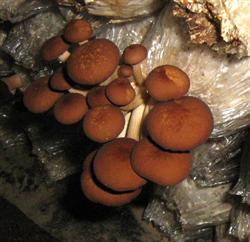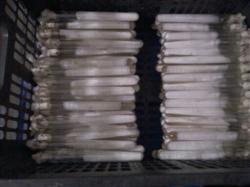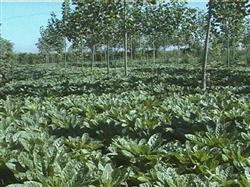How to cultivate and manage tea tree mushroom?

How to cultivate and manage tea tree mushrooms? please brief us on Agrocybe chaxingu is also called poplar mushroom, columnar field mushroom, willow matsutake, willow ring fungus, etc. It is one of the newly developed edible fungi varieties in recent years. The fruiting body of Agrocybe chaxingu is delicious, crispy and delicious, rich in protein, and is one of the most popular edible fungi in Europe and Southeast Asia. The main points of its cultivation techniques are as follows: Raw material selection and medium formulation. Mushroom is wood rot fungus. With broadleaf sawdust, cottonseed hull or crop straw as main raw materials, adding proper amount of bran, rice bran, corn flour, bean cake powder, oil meal, mixed feed, hyphae can grow vigorously and form normal fruiting bodies. The formula of culture medium: ① broadleaf sawdust 40%, cottonseed hull 40%, bran or rice bran 14%, corn flour or bean cake powder 5%, gypsum 1%. (2) Cottonseed hull 80%, bran or rice bran 14%, corn flour or bean cake powder 5%, gypsum 1%. (3) hardwood sawdust 69%, bran 30%, gypsum 1%.④ broadleaf sawdust 89%, mixed feed or oil meal 10%, gypsum 1%. The water content of each medium formula is 65%~75%, and the optimum ph is 5~6. Culture medium preparation and culture. The culture medium preparation method is the same as that of other bag-cultivated (wood-rot type) edible fungi. The cultivation of Agrocybe chaxingu is mostly cultivated in polypropylene plastic bags with specifications of 17 cm ×33~38 cm, and also cultivated in low pressure and high density polyethylene tubes with specifications of 15 cm ×55 cm or in bottles. Short bags are equipped with rings and cotton plugs, and each bag contains 0.2~0.3 kg of dry material; long bags contain 0.7 kg of dry material per cylinder. Routine sterilization, inoculation and incubation. The culture temperature is controlled at about 25℃, and the fruiting management can be carried out after the hyphae are fully grown. fruiting management. Mushroom room indoor or outdoor shade can be selected as the place for mushroom production. Generally, short bag cultivation or bottle cultivation adopts indoor mushroom house, and mushroom tube cultivation adopts outdoor shed cultivation. Indoor cultivation can be single-layer vertical shelf discharge or wall-type discharge, after the hyphae grow full bag, pull out the cotton plug, remove the collar, lift the plastic bag mouth upright, cover the newspaper, spray water 1~2 times a day, keep the newspaper moist, the air relative humidity is 85%~95%, the temperature is controlled at 16~28℃, the best 20~24℃, keep ventilation and certain scattered light. Another mushroom growing management method is to loosen the bag mouth to form mushroom bud after hyphae grow fully, move the mushroom bag to mushroom room after bud appears, cut the plastic at the bag mouth as mushroom bud grows, make mushroom bud grow around the material cylinder on the mushroom bag, and remove the mushroom bag downward as mushroom bud gradually appears from top to bottom around the material cylinder until it is completely taken off. Water is managed by spraying instead of spraying water directly onto the fruiting bodies. When the fungus tube is cultivated, after the hyphae are fully grown, a thin film on the inoculation hole surface is removed, and then the soil is arranged on the furrow surface and covered with soil, the soil thickness is about 1 cm. The site and covering soil shall be disinfected and disinfected before setting out, and water shall be sprayed on the soil surface after covering soil for 2 days to keep the soil moist. At low temperatures, the surface of the bed is covered with a thin film to keep warm and moist. Fruiting bodies occurred in large numbers about 10 days after opening. After harvesting, the water is stopped for 5 - 10 days to cultivate the bacteria, and then the second tide mushroom is managed. The fungus bags with good nutrition preservation can continue to produce mushrooms in the spring of the next year after overwintering. Click for more cultivation techniques of Agrocybe sinensis Click for more cultivation techniques of edible fungi
- Prev

How to cultivate Pleurotus ostreatus with liquid strain?
How to cultivate Pleurotus ostreatus with liquid strain? Please introduce the liquid strain cultivation of Pleurotus ostreatus can refer to the following methods: 1. The optimum temperature for mycelial production of Pleurotus ostreatus is 22lle 26 ℃, and the suitable fruiting body growth is 18Mel 25 ℃. Because the traditional cultivation method has a long cycle, it can do two seasons at most in a year, that is, spring.
- Next

What are the management points of Rehmannia glutinosa cultivation?
What are the management points of Rehmannia glutinosa cultivation? Please share the introduction of Rehmannia glutinosa planting management for reference: 1, cover grass: after planting and covering soil under Rehmannia glutinosa, cover the border with grass or other crops Artemisia stalk, which can inhibit the growth of weeds and keep the soil loose. 2. Interseedling: 20 murals 30 days after emergence.
Related
- Fuxing push coffee new agricultural production and marketing class: lack of small-scale processing plants
- Jujube rice field leisure farm deep ploughing Yilan for five years to create a space for organic food and play
- Nongyu Farm-A trial of organic papaya for brave women with advanced technology
- Four points for attention in the prevention and control of diseases and insect pests of edible fungi
- How to add nutrient solution to Edible Fungi
- Is there any good way to control edible fungus mites?
- Open Inoculation Technology of Edible Fungi
- Is there any clever way to use fertilizer for edible fungus in winter?
- What agents are used to kill the pathogens of edible fungi in the mushroom shed?
- Rapid drying of Edible Fungi

